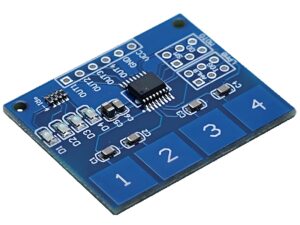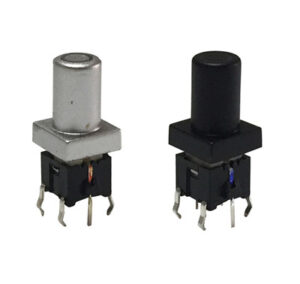A touch switch is a switch device that controls the on and off of a circuit by touch operation. It abandons the physical button structure of traditional mechanical switches and adopts advanced touch sensing technology to achieve a more convenient, sensitive and fashionable operating experience.
BEST Technology specializes in the production of different types of touch switches. From design to production, we strictly control the quality. Whether it is capacitive or resistive touch switches, they have extremely high sensitivity and stability.
What is a touch switch?
A touch switch is an electronic switch designed using the principle of touch sensing chips, mainly used to replace traditional mechanical button wall switches. It controls electrical appliances or lights and other equipment through partial contact with the human body, without pressing buttons. It can achieve switch control after touching. It is easy to operate, beautiful and does not require excessive force.
The working principle of the touch switch is based on the principle of inductive capacitance. When the human body touches the switch panel, a part of the capacitance value will be coupled to form a small current signal. These signals are amplified and filtered by the signal processing module and converted into digital signals, which then control the action of the relay to realize the opening and closing of the circuit.
Are touch switches reliable?
The reliability of touch switches is relatively high, but there are also some disadvantages.
Advantages of touch switches:
High safety: The touch switch adopts a fully enclosed design, which is not easy to damage, and has good waterproof and moisture-proof properties. It is not easy to cause electric shock and leakage during use.
Fast response speed: The touch switch responds quickly and can sense when the finger approaches, with a response time of less than 0.05 seconds.
Luminous navigation: Many touch switches are designed with luminous LED prompts for easy operation in the dark.
Easy to clean: The switch panel is thin and designed with dustproof function, which is easy to clean and does not require special maintenance.
What are the disadvantages of touch switches?
The disadvantages of touch switches mainly include the following aspects:
Sensitivity problem: Some touch switches may have problems such as fingers not being recognized or needing to be pressed hard, resulting in inconvenience in use.
Mistouch problem: The touch switch has high sensitivity and is easy to touch by mistake, resulting in accidental switching of lights or electrical appliances.
Environmental impact: The touch switch has high environmental requirements, and factors such as temperature, humidity, and static electricity may affect its normal use.
Power consumption: The household touch screen switch is always charged after being connected, and it will consume more power after use.
Short service life: The service life of the touch switch is relatively short, and it does not have a long service life like ordinary switches.
High price: Compared with traditional key switches, the manufacturing cost of touch switches is higher and the price is relatively more expensive.
Maintenance issues: After long-term use, the touch button may malfunction, causing the switch to fail.
How does a soft touch switch work?
The working principles of soft touch switches are mainly capacitive and resistive. The details are as follows:
1. Capacitive working principle:
Induction electric field formation: The circuit under the button of the capacitive soft touch switch will generate a uniformly distributed electrostatic field. The human body itself is conductive and carries a certain charge.
Capacitance value change: When a finger approaches or touches the touch panel of the switch, an additional capacitance is formed between the finger and the touch panel. The proximity of the finger causes the capacitance value between the touch panel and the finger to change, thereby increasing the total capacitance.
Signal detection and processing: When the change in capacitance value reaches the preset threshold, the detection circuit converts this change into an electrical signal and transmits it to the control chip. The control chip determines whether a touch operation occurs based on the received signal, and then controls the on and off of the switch to realize the opening or closing of the electrical equipment connected to the switch.
2. Resistive working principle:
Circuit conduction: Resistive soft touch switches are usually composed of two electrodes, and there is a certain resistance between the two electrodes. When a person’s finger touches the two electrodes, a conductive path is formed between the two electrodes due to its own conductivity, allowing current to pass.
Signal amplification and judgment: The amplifier or other current-sensitive element in the circuit detects the change in current and amplifies it. The amplified signal is transmitted to the control circuit, which determines whether it is a valid touch operation based on factors such as the strength and duration of the signal, thereby controlling the state switching of the switch.
In contrast, capacitive touch switches are more widely used because they have higher sensitivity and stability, and can achieve touch operations through a certain thickness of insulating material. The circuit of the resistive touch switch is relatively simple, but it may require a greater pressing force during use and is easily affected by environmental factors.
How to test a touch switch?
Appearance inspection: Check whether the surface of the touch switch has obvious physical damage such as breakage, cracks, scratches, etc. If these problems exist, it may affect the normal operation of the switch and be easily affected by external factors such as dust and moisture.
Functional test: Gently touch the touch area of ??the switch with your finger or other touch tool to check whether the switch can respond to touch operations quickly and accurately. Touch the touch area in different positions multiple times to ensure that the switch can work properly in all positions.
Performance test: Test the sensitivity of the touch switch under different environmental conditions, such as different temperatures, humidity, and light. For example, in a humid environment, the touch switch may be affected by moisture and cause a decrease in sensitivity.
Pressure test: Use professional pressure testing equipment, or simulate different pressures by placing objects of different weights on the switch to check whether the switch can accurately identify pressure changes and respond according to the preset functions.
What is a capacitive touch switch?
A capacitive touch switch is an electronic component that uses the capacitance of the human body and objects to sense touch actions and switch states. Its working principle is based on the change of capacitance. When a finger or other object approaches the sensing area of ??the capacitive touch switch, a capacitance change occurs. The circuit inside the switch senses the touch action by detecting this change and switches the switch state.
A capacitive touch switch is mainly composed of the following parts:
Shell: Usually made of plastic or metal materials, the shape and color can be designed according to the specific application scenario.
Touch panel: Made of conductive materials, such as metal or conductive coating, common shapes include round, square and rectangular, etc.
Inductive circuit: It is composed of multiple conductive layers and insulating layers, and is used to sense and detect touch actions.
Control circuit: It processes the signal output by the inductive circuit and switches the switch state according to the touch action.
What is the difference between inductive and capacitive switches?
There are significant differences between inductive and capacitive proximity switches in terms of working principle, detection material and response speed.
1. Working principle
Inductive proximity switch: It uses a sensing head with a coil. When a metal object approaches, the magnetic circuit where the sensing head is located changes, generating an electromotive force, thereby changing the state of the output circuit.
Capacitive proximity switch: It detects the approach of an object by measuring the capacitance of a capacitor. When an object approaches a capacitive proximity switch, the capacitance between the electrodes changes, thereby changing the working state of the switch.
2. Detection material
Inductive proximity switch: It is usually used to detect conductive materials such as iron, copper, and aluminum, and has poor induction effect on non-metallic objects.
Capacitive proximity switch: It can work on a wider range of materials, including non-metallic materials such as plastic, wood, paper, and glass, and is suitable for objects of various materials.
3. Response speed
Inductive proximity switch: reacts faster to larger objects, but slower to smaller objects.
Capacitive proximity switch: has smaller restrictions on the size of objects and faster response speed.
In short, a touch switch is a switch device that uses capacitive sensing or resistive sensing technology to control the on and off of a circuit through touch operation. It has the advantages of being stylish, easy to operate, safe and reliable, energy-saving and environmentally friendly, and is widely used in home decoration, commercial places and industrial fields.







